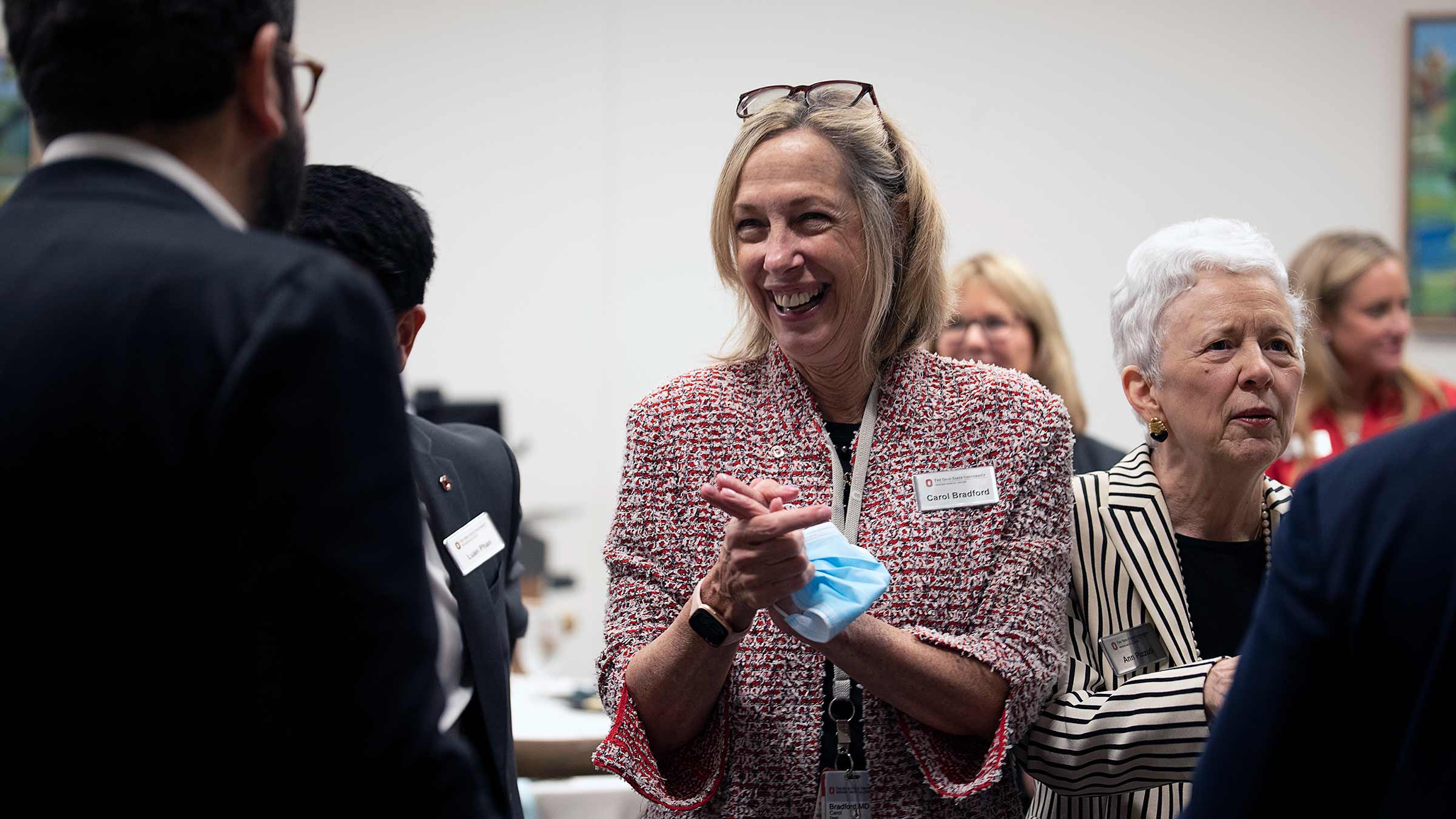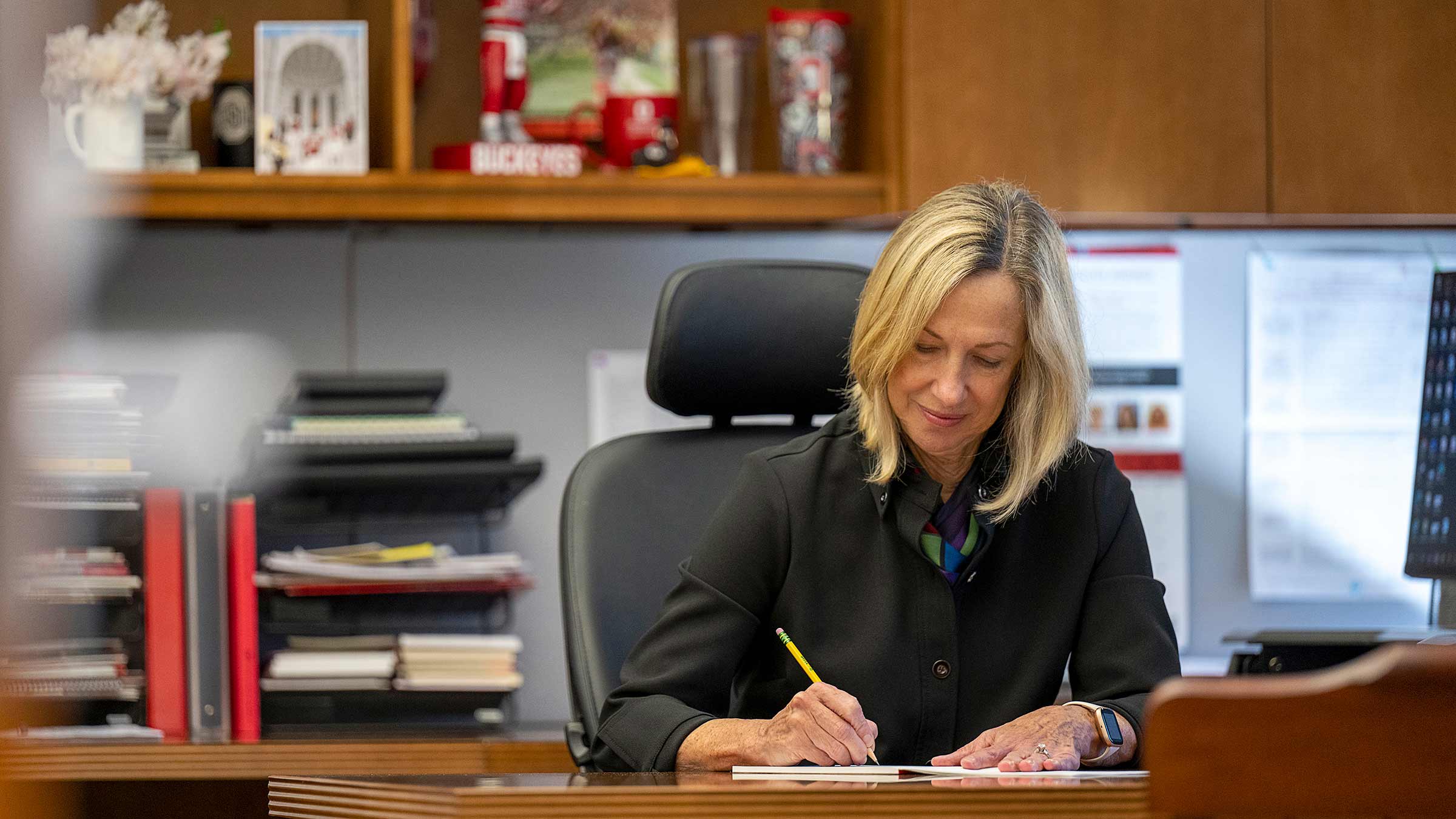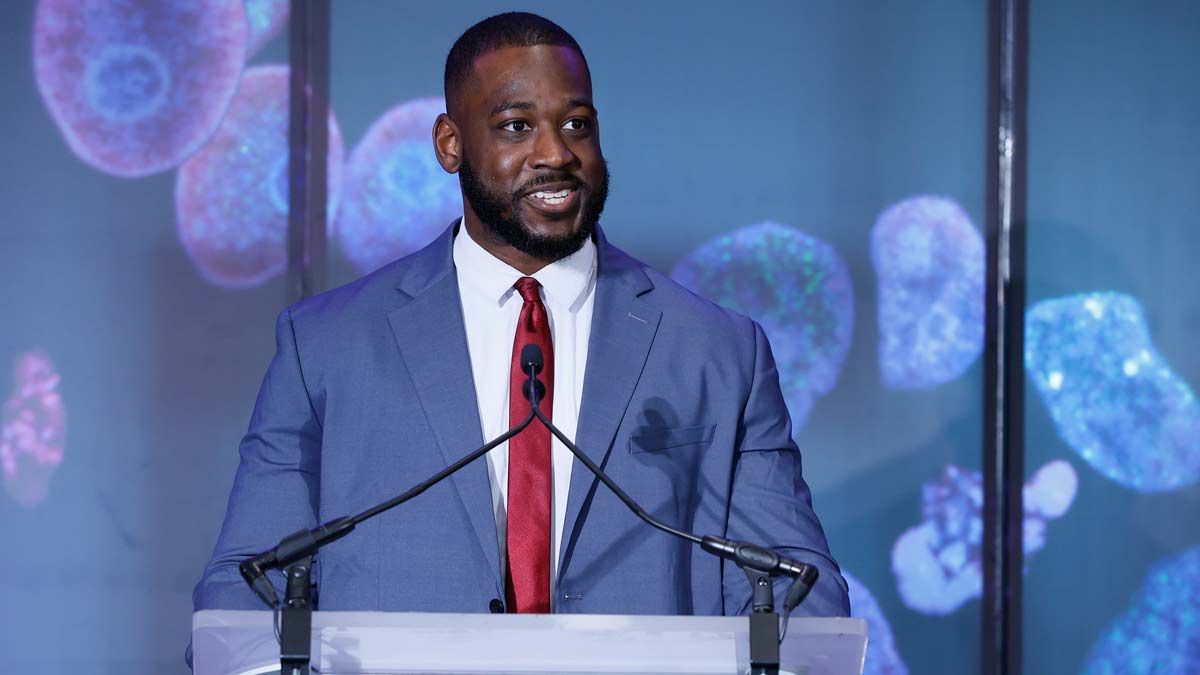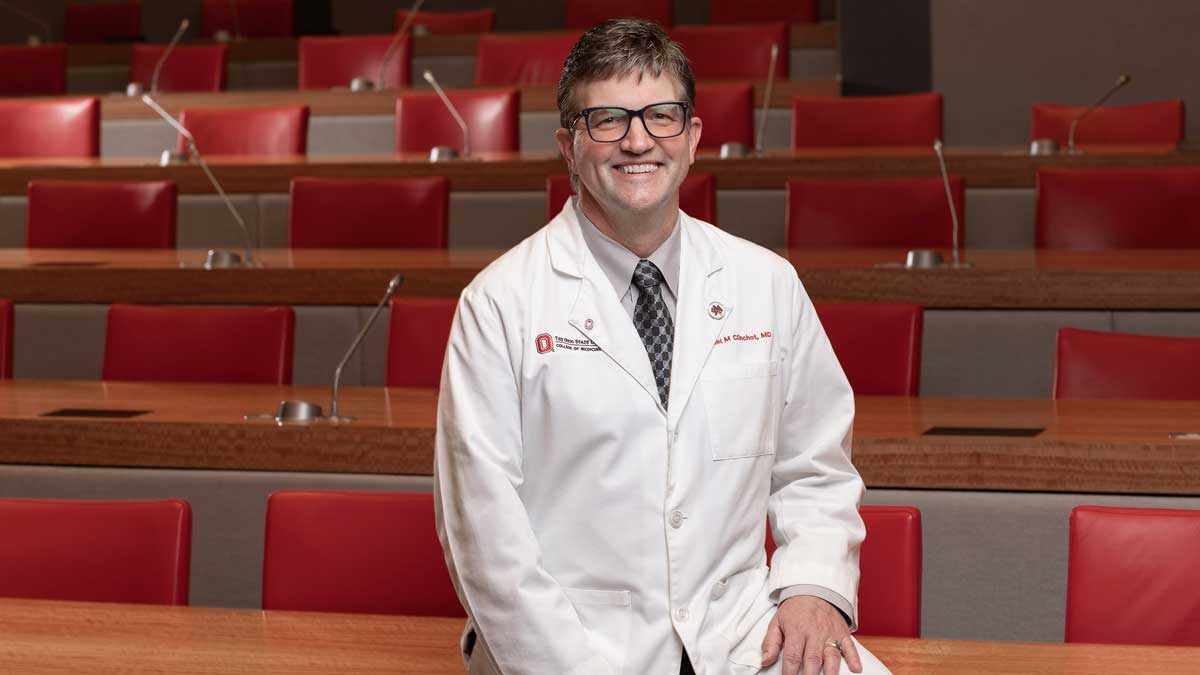Uniting people to a cause to address big challenges in health care
Carol R. Bradford, MD, MS, FACS, a cancer surgeon-scientist turned medical school dean, is solving problems through collaboration.
As a child growing up in southeast Michigan, Carol Bradford made a decision that shaped her life and that of countless others.
The youngest of four children, she loved math and science, and with an assist from her older sister, she was reading before she went to kindergarten. Her father was an attorney and her mother worked as an office manager.
But in sixth grade, she had decided that her calling was to help others.
“I said, ‘I want to help people, I want to become a doctor,’” she says. “I knew exactly that’s what I wanted and I never changed my mind, despite really having no role models in medicine. I just knew that was the way to help people with health challenges.”
Her determination at a young age led to her rise as a premier head-and-neck cancer surgeon and a leading researcher. It also set her on a path toward leadership roles in academic medicine.
The choice is also a testament to some core traits for Carol R. Bradford, MD, MS, FACS: her empathy and her resolve. Now the dean of The Ohio State University College of Medicine and vice president for Health Sciences at The Ohio State University Wexner Medical Center, Dr. Bradford has made a mark by uniting people to address the most pressing health care challenges.

Finding a calling as a physician-scientist
Dr. Bradford is a champion of public education and was a standout student. As an undergraduate, she was in the honors college at the University of Michigan, where she earned her degree in cellular and molecular biology. The long hours in the graduate library were beneficial in more ways than one — during her freshman year, she met civil engineering major David Bradford there and they married the summer before she entered medical school.
Early during her time at the University of Michigan Medical School, she decided she wanted to focus on otolaryngology — a specialty focusing on the ears, nose and throat. It was during her surgical residency at Michigan that she noticed a pattern in patients who had tumors at the base of their tongues.
“I would see patients, and to look at their tumors, they would look exactly the same,” Dr. Bradford says. “In one patient, the tumor would sort of melt away with chemotherapy and radiation, and the other patient’s tumor wouldn’t respond at all. For me, that was a very interesting biological question.”
Dr. Bradford had been doing medical research since her time as an undergraduate and had her own lab once she joined Michigan’s faculty as a head and neck cancer surgeon. There, she was part of a team that established that the presence of human papillomavirus (HPV) made tumors more responsive to treatments. This explained why Dr. Bradford was seeing such different outcomes in her patients, and it paved the way for testing to determine whether a patient’s tumor was caused by HPV.
Knowing what had caused the tumor would allow physicians to better tailor treatments for patients, helping them avoid negative side effects from surgery or chemotherapy.
“If you’re a clinician, you can treat one patient at a time, but you can’t answer the big questions that can really help many, many patients,” Dr. Bradford says. “I just wanted to try and help answer some of those bigger questions.”

A commitment to the future of health care
As her career progressed, Dr. Bradford began taking leadership positions within academia as well. She joined the faculty at the University of Michigan in 1992 as an assistant professor of otolaryngology, and in 2009 she became chair of the Department of Otolaryngology. Seven years later, she rose to serve as executive vice dean for academic affairs.
Her decision to pursue leadership roles in academia was based on the same sentiment that fueled her desire to do research in addition to her clinical work.
“I think that, like making a scientific discovery to help many, when you educate future generations of clinicians, scientists and leaders, you’re making a huge impact,” Dr. Bradford says. “Helping mentor, sponsor and support people through their careers, you benefit many more people than the individual clinical interactions.”
Dr. Bradford’s experience as a department chair has been especially meaningful to Pari Pandharipande, MD, professor and chair of Radiology at the Ohio State Wexner Medical Center.
“She has been a department chair in her past, which is incredibly helpful,” Dr. Pandharipande says. “Her clinical operational skills, having served as a chair and in the operating room, really make her an expert in most things that patients experience in the hospital system.
“When you have a challenge that you want her help with, as many of us as chairs do, what’s remarkable is that she will understand the big picture, but also all the way down to the granularity of how patients move through the system,” Dr. Pandharipande says.
Dr. Bradford’s wealth of experience in research, education and patient care made her an ideal fit to serve as the 15th dean of the Ohio State College of Medicine, a position she took in 2020. While her current role leans heavily on administrative responsibilities, she continues to treat patients at The Ohio State University Comprehensive Cancer Center – Arthur G. James Cancer Hospital and Richard J. Solove Research Institute. She also holds the Leslie H. and Abigail S. Wexner Dean’s Chair in Medicine.
That broad base of experience helps make Dr. Bradford an effective leader, says Dana McTigue, PhD, associate dean for Foundational Research at the Ohio State College of Medicine.
“I’ve been here for quite a while, and I’ve been through a lot of College of Medicine deans. She is definitely the most supportive and interested in promoting the research,” Dr. McTigue says. “She has the rare perspective of having skills in all three areas of the tripartite mission. She knows what the struggles of getting a grant are, or the excitement of getting cool new data. She really has the lived experience.”
Dr. Bradford is proud of how she has been able to balance professional and family life. She and son Taylor shared many hours on the tennis court as he was growing up, and Dr. Bradford was a self-described “gymnastics mom” to daughter Morgan, who competed at the collegiate level.
“I have worked really hard most of my life,” Dr. Bradford says. “But the scope of this job as dean is the biggest. Probably this is as hard as I’ve ever worked.”
Like her mom before her, Morgan is now pursuing a career in medicine.
“Women in medicine used to pursue pediatrics and Ob/Gyn. But the surgical disciplines have changed a lot over the course of my career,” Dr. Bradford says. “My daughter is a fourth-year medical student. She has had colleagues who have been told, ‘Well, you can’t be a surgeon and a mother.’ And this is why I say, ‘Don’t let other people define what you can or cannot become.’”

A collaborative leader
Evans Osuji arrived at the Ohio State College of Medicine in the fall of 2020, just as Dr. Bradford was settling into her role as dean. Now a fourth-year medical student, the New Jersey native has had a first-person view of Dr. Bradford’s leadership style, having served as executive director for Diversity, Equity and Inclusion on student council, among other leadership roles.
Osuji is especially impressed by her ability to make personal connections with students.
“The dean is definitely somebody who appreciates academic excellence.

“Dean Bradford has made it a point of emphasis on several occasions to let it be known that students’ well-being is an absolute top priority to her,” Osuji says.
“She has mastered the ability to juggle her various roles here at the College of Medicine while also regularly prioritizing new and established relationships between student learners — all without sacrificing the quality of her work in either capacity,” Osuji says. “We get an opportunity to see more of the humanistic side of who she is as both a dean and a person.”
That ability to make personal connections is a core reason Dr. Bradford has been a strong leader of the college, according to Daniel Clinchot, MD, vice dean for Education at the Ohio State College of Medicine and the Harry C. and Mary Elizabeth Powelson Professorship of Medicine at the College of Medicine
 “She’s really had a focus on the culture within the College of Medicine,” Dr. Clinchot says. “There’s not a lot of deans who focus on that. Part of the way she does that is her engagement. She spends a lot of time being present for faculty, staff and learners.”
“She’s really had a focus on the culture within the College of Medicine,” Dr. Clinchot says. “There’s not a lot of deans who focus on that. Part of the way she does that is her engagement. She spends a lot of time being present for faculty, staff and learners.”
The relationships Dr. Bradford facilitates pay off in tangible ways. She played a major role in helping to launch the Community Medicine MD Track through the Healthy State Alliance, a partnership between the Ohio State Wexner Medical Center and Mercy Health, the state’s largest health system.
The collaborative effort aims to improve lives throughout Ohio by bringing more health care services to underserved parts of the state. Medical students with an interest in working in these communities will spend two years learning on the main Ohio State campus, then will go to Lima, a small city in northwest Ohio, for clinical rotations as part of the Healthy State Alliance. The first class will be admitted in 2024.
One of Dr. Bradford’s other key projects has been the creation of the new home for the College of Medicine. The $157.3 million Interdisciplinary Health Sciences Center project is a renovation of 120,000-square-foot Hamilton Hall, as well as the construction of a new, 100,000-square-foot building. Students began classes in the new building in January 2022, and the final phase of the five-year project began in June 2023.
“I am so excited for this project,” Dr. Bradford says. “This building will give our health science learners the spaces, technology and resources they need to learn and grow together as the next generation of leaders in health care.”

An enthusiastic outlook
The health care industry faces a number of challenges, including access to care for patients, fiscal issues and staffing shortages.
Dr. Bradford acknowledges these problems (“opportunities,” in her parlance) but is optimistic about the role the College of Medicine will play in addressing them.
Among her reasons for optimism is Ohio State’s role helping to provide research and data for the State of Ohio Adversity and Resilience (SOAR) Study as part of a statewide network. She partnered with K. Luan Phan, MD, chair of the Department of Psychiatry and Behavioral Health, and other leaders at the medical center, university and state to create the framework for SOAR, which will bring together academic, clinical, community and government partners across the state of Ohio to conduct a population-based visionary multigeneration research study to discover insights about risk and resilience in brain health. The program was launched with $20 million in state funding in 2023.
“The opportunities are enormous,” she says. “We are really well positioned here for a huge number of reasons. I have never worked at anything other than a fully integrated academic medical center in my whole career. I think public universities have something very special to offer.
“The next five or 10 years are going to be fascinating. The community support, the growth of programs, and our great faculty, learners and staff. It’s a very exciting time. We are going to make huge discoveries that transform the health of our communities.”

The future of medicine is at Ohio State
Our innovative curriculum, life-altering biomedical research and unsurpassed patient care make us one of the top medical schools in the country.
Explore our programs



